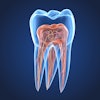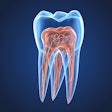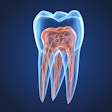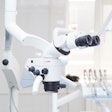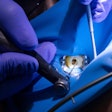In the 1967 movie, “The Graduate,” a young Dustin Hoffman plays an aimless young man named Benjamin Braddock who just graduated from college. His upscale parents host a graduation party at their swanky home in his honor. During the party, one of his dad’s martini-fueled friends, Mr. McGuire, throws his arm around Ben’s shoulder to share the following career advice:
Mr. McGuire: "I want to say one word to you. Just one word."
Benjamin: "Yes, sir."
Mr. McGuire: "Are you listening?"
Benjamin: "Yes, I am."
Mr. McGuire: "Plastics."
Benjamin: "Exactly how do you mean?"
Mr. McGuire: "There's a great future in plastics. Think about it. Will you think about it?"
I had a similar “plastics” moment about 10 years ago. It was during the Chicago Midwinter Meeting, and I was having breakfast at the Hyatt McCormick with my friend and fellow Jersey guy Dr. Marty Jablow. As usual, we were talking about dental technology.
Me: "Marty, what’s the next big thing in dental technology?"
Marty: "AI."
Me: "What?"
Marty: "Artificial intelligence. It’s gonna change everything."
I never forgot that conversation. I recently caught up with Marty to discuss how far AI has come and where it is headed.
Michael Ventriello: AI in dentistry is no longer a futuristic concept, but how much of what’s marketed as AI is true artificial intelligence?
Dr. Mary Jablow: AI in dentistry is indeed a reality, with applications like automated radiograph analysis, treatment planning, and patient management systems already in use, but much of what’s marketed as “AI” is often “AI lite” --sophisticated algorithms or machine-learning models that fall short of true AI.
True AI would involve systems capable of autonomous reasoning; learning from diverse data; and adapting to complex, unpredictable scenarios without human intervention, akin to general intelligence.
While most dental AI tools lack the adaptability and reasoning of true AI, these “AI-lite” systems are transforming dental practices by streamlining workflows and enhancing diagnostic accuracy, even if they don’t fully live up to the sci-fi promise of AI.
How would you respond to practitioners who are skeptical or even resistant to adopting AI in their workflow?
I’d emphasize that AI is a tool designed to enhance, not replace, clinical judgment, acting as a supportive partner that handles repetitive tasks and augments decision-making with data-driven insights.
Far from threatening their role, AI can streamline workflows, automating radiograph analysis, predicting treatment outcomes, or managing patient records, freeing dentists to focus on complex diagnoses, patient interaction, and personalized care.
Resistance often stems from fear of the unknown or overhyped marketing, but embracing AI gradually allows practitioners to see tangible benefits like improved efficiency, fewer errors, and better patient outcomes while retaining full control.
 Michael Ventriello.
Michael Ventriello.
Where do you see AI making the biggest clinical impact right now?
Right now, AI is making its biggest clinical impact in dentistry through diagnostics, particularly in the analysis of dental imaging like radiographs, cone-beam computed tomography (CBCT) scans, and intraoral scans, where it excels at detecting patterns and anomalies with high precision.
Tools powered by machine learning can identify caries, periodontal disease, or even early signs of oral cancer faster and often more accurately than the human eye, flagging potential issues for dentists to review.
While AI also enhances treatment planning by simulating outcomes or optimizing orthodontic aligner designs and improves patient communication through automated scheduling and chatbots, its diagnostic capabilities stand out due to their immediate impact on accuracy and efficiency.
These systems reduce missed diagnoses, catch subtle abnormalities, and allow dentists to focus on interpreting results and crafting patient-specific strategies, making diagnostics the area where AI’s transformative power is most evident today.
Can you share a real-world example where AI changed the course of diagnosis or treatment in a way a traditional exam may not have?
A compelling real-world example of AI changing the course of dental diagnosis comes from the use of AI-powered radiograph analysis tools, such as those developed by companies like Pearl or Denti.AI.
In one documented case, an AI system analyzing routine dental x-rays flagged a subtle radiolucency in the jaw that was initially overlooked during a traditional exam by a general dentist. The AI’s detection algorithm, trained on thousands of images, identified the anomaly as a potential ameloblastoma, a rare, benign but aggressive tumor.
By catching this early, the AI enabled a less complex surgical intervention, preserving more of the patient’s jaw structure and improving the outcome, demonstrating how AI can enhance diagnostic precision beyond standard visual exams.
How do you see AI changing the dentist-patient relationship?
AI has the potential to significantly enhance the dentist-patient relationship by improving transparency, accuracy, and communication, though its impact depends on how it’s integrated into practice.
For instance, showing a patient an AI-highlighted cavity on a digital scan can make the need for treatment tangible, reducing skepticism. However, if poorly implemented, such as overrelying on AI without clear dentist-led explanations, it can create confusion or mistrust, as patients may question the “black box” nature of AI decisions or feel disconnected from a human-centric approach.
In your opinion, which dental specialties will be most transformed by AI over the next five years, and which may be slower to evolve?
Over the next five years, dental specialties like orthodontics and oral radiology are poised to be the most transformed by AI, driven by their reliance on imaging and data-driven planning.
In orthodontics, AI is already optimizing aligner design, predicting tooth movement, and personalizing treatment plans with tools like those from Align Technology, while in oral radiology, AI enhances the detection of pathologies in x-rays and CBCT scans with unmatched precision, as seen with platforms like Pearl.
Endodontics is another specialty beginning to see meaningful integration of AI, particularly in diagnosis and treatment planning. AI algorithms are being trained to analyze periapical radiographs and CBCT scans to detect periapical lesions, root fractures, and canal morphology with increasing accuracy, often identifying subtleties that may be missed by the human eye.
Platforms like Diagnocat and Overjet are being explored for their potential in assisting with endodontic diagnostics. AI also supports more precise length determination and canal navigation in complex root canal anatomies, reducing the risk of missed canals or overinstrumentation.
As digital imaging becomes standard and data collection expands, AI will increasingly assist endodontists in improving treatment outcomes and case predictability, although the specialty's reliance on tactile skill still places it between the fast adopters and slower-evolving disciplines.
In periodontology, AI is beginning to reshape how clinicians diagnose and monitor periodontal disease. Through analysis of radiographs and intraoral scans, AI-powered platforms can detect early signs of bone loss, measure pocket depths, and assess disease progression with impressive consistency.
Tools such as those developed by companies like DentalMonitoring and VideaHealth offer the ability to track subtle changes over time, enhancing preventive care and improving patient communication.
Moreover, AI is facilitating risk assessment by integrating patient health records, habits, and genetic predispositions to predict susceptibility to periodontal disease. While hands-on procedures like scaling and root planing remain human-led, AI is augmenting decision-making, case documentation, and long-term maintenance strategies, making it a valuable ally in chronic disease management. These dental specialties benefit from AI’s ability to process large datasets and identify patterns, streamlining workflows and improving outcomes.
Conversely, specialties like oral surgery and prosthodontics may evolve more slowly, as they involve complex, hands-on procedures and nuanced clinical judgment that AI can support but not fully automate.
There’s a growing debate over data privacy and AI. As more practices use cloud-based diagnostic platforms, how can dentists protect patient data while embracing digital innovation? Also, who owns the data?
 Dr. Marty Jablow.
Dr. Marty Jablow.
Dentists can safeguard data by using HIPAA-compliant platforms with end-to-end encryption, multifactor authentication, and regular security audits, as recommended by the ADA, while ensuring vendors adhere to strict privacy standards like the General Data Protection Regulation (GDPR) or the California Consumer Protection Act, where applicable.
Staff training on data handling and obtaining informed patient consent for AI use are also critical to prevent breaches.
Regarding data ownership, it typically resides with the dental practice as the data controller, but this can vary based on contracts with AI vendors, who may retain rights to de-identified data for model training unless explicitly prohibited.
Dentists must review vendor agreements to clarify ownership and usage rights, ensuring transparency with patients to maintain trust. By balancing these measures, practices can leverage AI’s benefits, such as enhanced diagnostics, while prioritizing patient privacy and maintaining control over sensitive data.
There are currently several AI companies that interpret radiographs. Is there room for all of them? Do you see consolidation on the horizon?
The dental AI market, particularly for radiograph interpretation, is crowded with players like Pearl, Overjet, Denti.AI, and Diagnocat, each offering specialized tools to enhance diagnostic accuracy and efficiency.
While there’s room for multiple companies due to the growing demand for AI-driven diagnostics -- projected to reach a $2.8 billion market by 2029 -- intense competition and high development costs may drive consolidation in the next few years.
Smaller practices struggle to afford sophisticated AI systems, and strict data privacy regulations like HIPAA and GDPR add barriers, favoring larger, well-funded companies or those integrated with established dental imaging platforms like Align Technology.
What’s more, as dental service organizations (DSOs) and larger practices prioritize seamless integration and standardized solutions, mergers or acquisitions are likely, with dominant players like Overjet, already backed by significant funding, or Pearl, with its extensive radiograph dataset, potentially absorbing smaller competitors to streamline the market and enhance interoperability, mirroring trends in broader healthcare AI.
Do you see AI becoming a catalyst for more medical-dental collaboration? If so, can you give examples?
AI is poised to be a significant catalyst for medical-dental collaboration by integrating patient data across disciplines, enabling holistic care and uncovering connections between oral and systemic health that might otherwise be missed.
For instance, AI platforms analyzing dental records alongside medical data could identify correlations, such as periodontal disease linked to diabetes or cardiovascular risks, prompting coordinated interventions between dentists and physicians.
A real-world example is the integration of AI tools like those from Epic Systems, which combine dental and medical EHRs, allowing dentists to share AI-flagged findings, like oral signs of systemic conditions, with medical providers for joint treatment planning.
Similarly, AI-driven teledentistry platforms can facilitate referrals by analyzing images and alerting primary care physicians to oral health issues that impact conditions like sleep apnea or rheumatoid arthritis.
By breaking down data silos and providing actionable insights, AI fosters interdisciplinary communication, encouraging dentists and medical professionals to collaborate on preventive care and chronic disease management, ultimately improving patient outcomes.
In conclusion, how should dentists vet AI-powered technologies before incorporating them into their practice? What questions should they be asking vendors? How do they calculate the return on investment (ROI)?
Dentists should vet AI-powered technologies by prioritizing clinical relevance, data security, and integration ease, ensuring the tools align with their practice’s needs and enhance patient care without compromising trust.
Key questions to ask vendors include:
What specific problems does the AI solve (e.g., diagnostics, workflow efficiency)?
Is it HIPAA-compliant with robust encryption and data privacy measures?
How was the AI trained, and is it validated with peer-reviewed studies or real-world evidence?
Can it integrate seamlessly with existing practice management software and imaging systems?
What are the training and support options for staff adoption?
To calculate ROI, dentists should assess upfront costs (subscription, hardware, or training) against measurable benefits like time saved on diagnostics (e.g., faster radiograph analysis), increased case acceptance due to AI-driven visualizations, or reduced errors leading to fewer costly re-treatments. They should also consider long-term gains, such as improved patient outcomes and retention, while factoring in ongoing costs like updates or subscriptions. By rigorously evaluating efficacy, security, and financial impact, dentists can confidently adopt AI tools that deliver tangible value to their practice.
Dr. Marty Jablow is America's Dental Technology Coach. He practices general dentistry in a group setting in Woodbridge, NJ. Jablow promotes the use of technology in the dental office to improve efficiency and patient care. He lectures and writes articles on the use of technology to enhance the practice of dentistry. He can be reached by email at marty@ dentaltechnologycoach.com.
Michael Ventriello is widely regarded as the “Dental Product Launch Expert.” He is the owner and founder of the PR-forward dental marketing agency, Ventriello Communications and also the co-founder and chief communications officer of Personify Group, Dentistry’s Brand Growth Partner. Ventriello is an award-winning copywriter and PR practitioner, former journalist, broadcaster, a frequently published author, and dental industry pundit. Connect with him on LinkedIn.
The comments and observations expressed herein do not necessarily reflect the opinions of DrBicuspid.com, nor should they be construed as an endorsement or admonishment of any particular idea, vendor, or organization.

